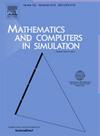An automatic differentiation-enhanced meshfree finite block method for nonlinear problems
IF 4.4
2区 数学
Q1 COMPUTER SCIENCE, INTERDISCIPLINARY APPLICATIONS
引用次数: 0
Abstract
This paper presents an Automatic Differentiation–Enhanced Meshfree Finite Block Method (AD-FBM) for solving strongly nonlinear partial differential equations (PDEs). The physical domain is divided into blocks, each mapped to a normalized standard domain, where shape functions are constructed via Lagrange polynomials. The automatic differentiation method computes exact derivatives of nonlinear material constitutive laws and PDE operators, significantly reducing the human effort and errors often associated with manual coding of Jacobians. The AD-FBM is validated through several benchmark problems, including a steady-state nonlinear heat conduction example, a bi-material scenario with thermal contact resistance, a large-deflection cantilever beam under follower loads, and a rectangular plate with a circular hole made of hypo-elastic materials. Each of which demonstrates excellent agreement with analytical or finite element solutions. The results show that the AD-FBM converges efficiently via Newton’s iteration, underscoring the advantages of integrating automatic differentiation with meshfree finite block method. The AD-FBM significantly reduces the coding complexity and the risk of errors associated with manual derivative computations for robust and flexible simulations of complex nonlinear PDEs.
非线性问题的自动微分增强无网格有限块法
提出了一种求解强非线性偏微分方程的自动微分增强无网格有限块法。物理域被划分为块,每个块映射到一个规范化的标准域,其中形状函数通过拉格朗日多项式构造。自动微分方法计算非线性材料本构律和偏微分算子的精确导数,大大减少了人工编码雅可比矩阵的工作量和错误。AD-FBM通过几个基准问题进行了验证,包括稳态非线性热传导示例、具有热接触电阻的双材料场景、受随动载荷的大挠度悬臂梁以及由亚弹性材料制成的带圆孔的矩形板。每一个都与解析解或有限元解非常吻合。结果表明,通过牛顿迭代,AD-FBM能够有效收敛,凸显了将自动微分与无网格有限块法相结合的优势。AD-FBM显著降低了编码复杂度和与手工导数计算相关的误差风险,实现了复杂非线性偏微分方程的鲁棒和灵活仿真。
本文章由计算机程序翻译,如有差异,请以英文原文为准。
求助全文
约1分钟内获得全文
求助全文
来源期刊

Mathematics and Computers in Simulation
数学-计算机:跨学科应用
CiteScore
8.90
自引率
4.30%
发文量
335
审稿时长
54 days
期刊介绍:
The aim of the journal is to provide an international forum for the dissemination of up-to-date information in the fields of the mathematics and computers, in particular (but not exclusively) as they apply to the dynamics of systems, their simulation and scientific computation in general. Published material ranges from short, concise research papers to more general tutorial articles.
Mathematics and Computers in Simulation, published monthly, is the official organ of IMACS, the International Association for Mathematics and Computers in Simulation (Formerly AICA). This Association, founded in 1955 and legally incorporated in 1956 is a member of FIACC (the Five International Associations Coordinating Committee), together with IFIP, IFAV, IFORS and IMEKO.
Topics covered by the journal include mathematical tools in:
•The foundations of systems modelling
•Numerical analysis and the development of algorithms for simulation
They also include considerations about computer hardware for simulation and about special software and compilers.
The journal also publishes articles concerned with specific applications of modelling and simulation in science and engineering, with relevant applied mathematics, the general philosophy of systems simulation, and their impact on disciplinary and interdisciplinary research.
The journal includes a Book Review section -- and a "News on IMACS" section that contains a Calendar of future Conferences/Events and other information about the Association.
 求助内容:
求助内容: 应助结果提醒方式:
应助结果提醒方式:


